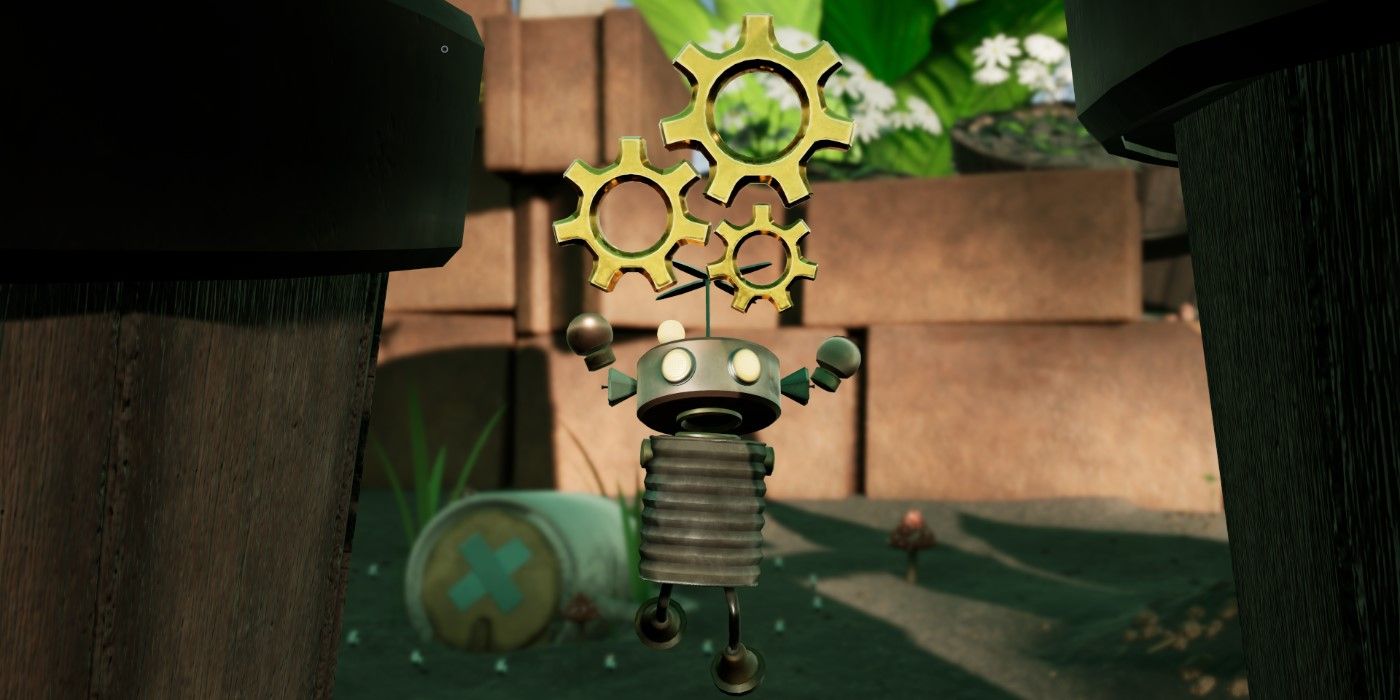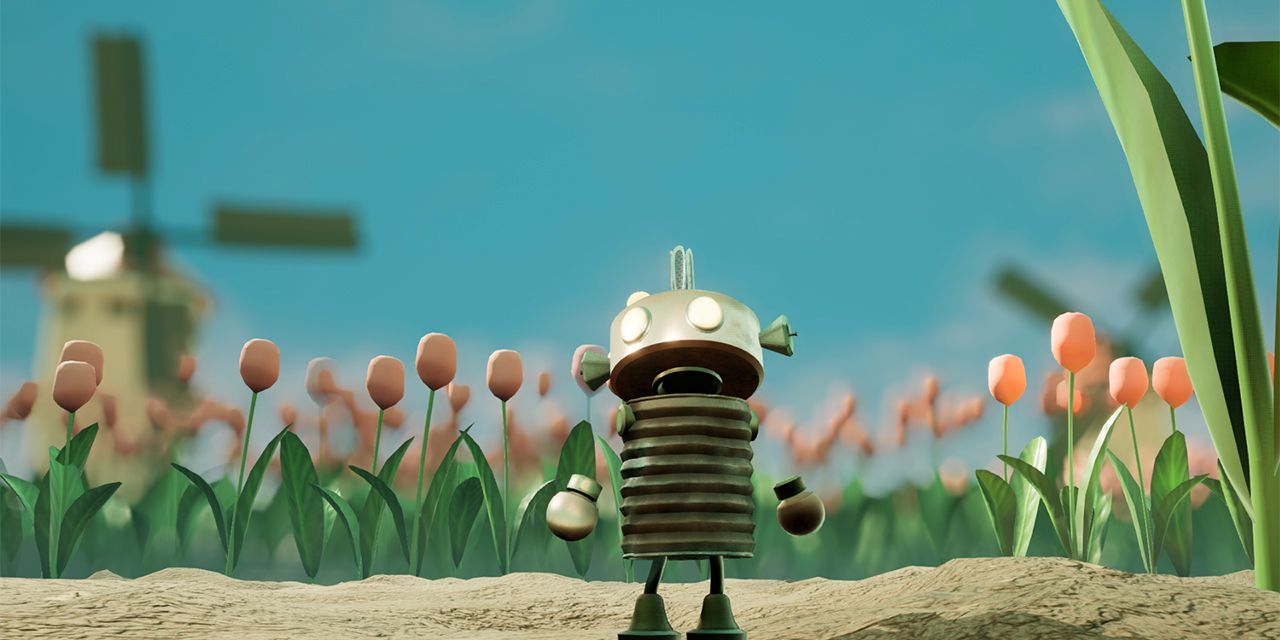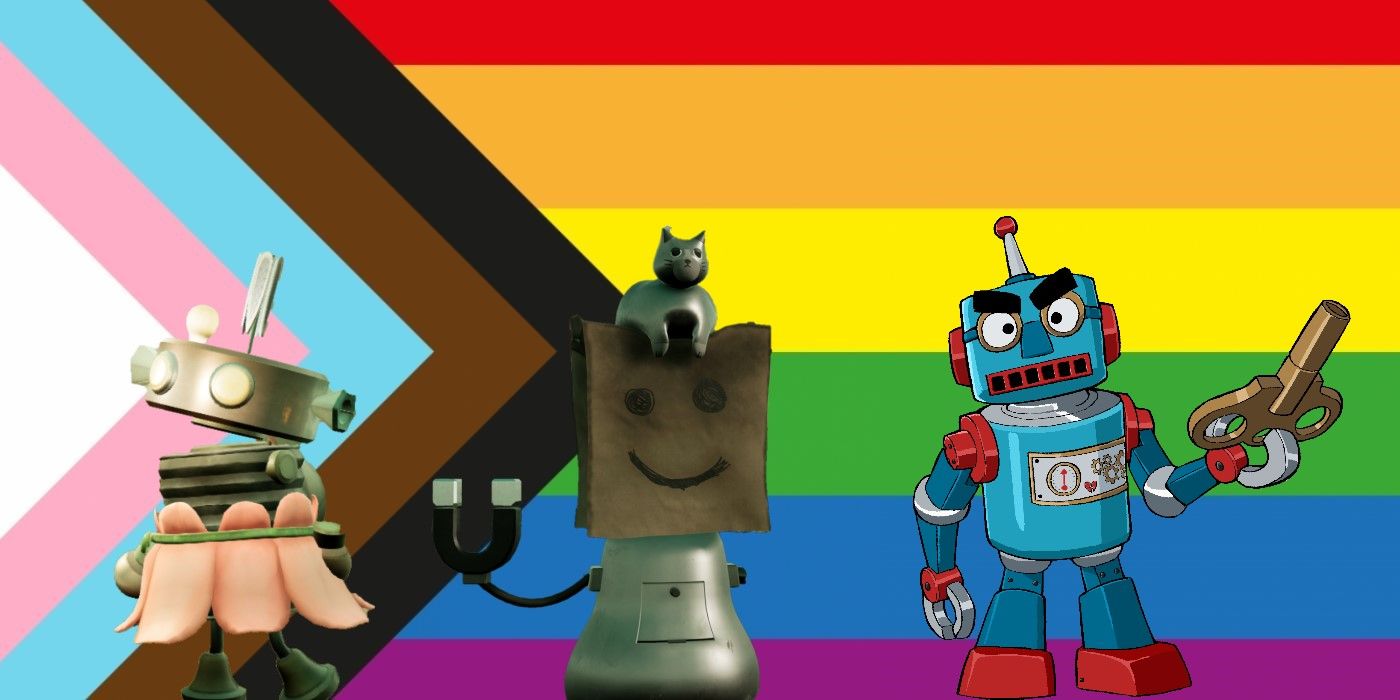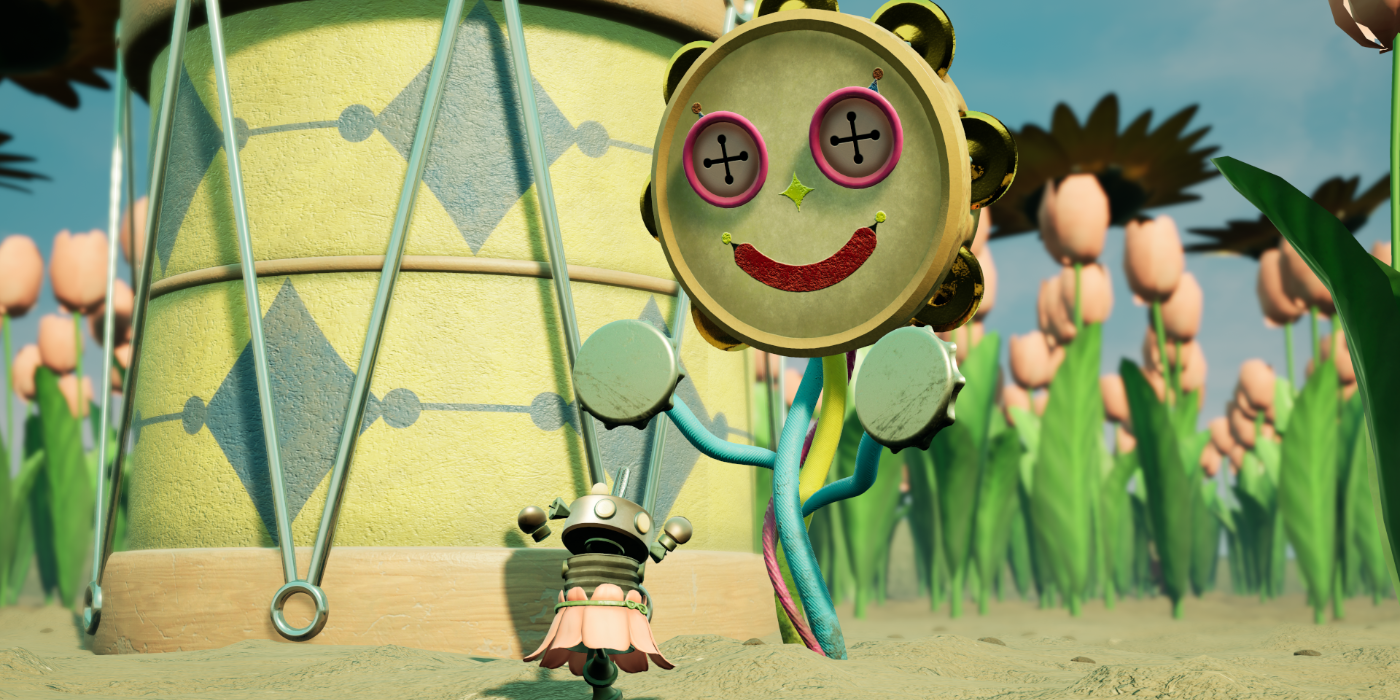
Misc. A Tiny Tale is a platforming game about tiny robots and their quest for acceptance, while gathering golden cogs and helping all sorts of other robots along the way. There is a lot to do in Misc., and the game is designed to allow players to choose how they want to progress by providing a general direction, even though the path to get there is not necessarily linear. Game Rant spoke to the founder of Tinyware Games, Michael Pearce, about what it meant to develop Misc. A Tiny Tale and what game development in general means to him.
This game offers a unique take on a familiar experience, he said, and it also challenges the players' perspective on diversity and what it means to be a person - or a robot. The game's cute aesthetics make it an even more wholesome title, which holds a lot of surprises for players who will dare to try it. Interview has been edited for brevity and clarity.
RELATED: Tinyware Games’ Founder Describes Misc. A Tiny Tale’s Branching Puzzle Design and Story Progression

Q: Is Misc. A Tiny Tale your very first project or were there others you worked on before?
A: So, Misc. is our first commercial project. This is the first time we've entered the industry and have a game for sale on Steam. Before that, I've made a fan project with a lot of the same team members that we did for about three years. It was called Jurassic Explorer and it was a recreation of the park of Jurassic World. We made it to replicate the park and walking around dinosaurs, adding a few collectibles and stuff. We built our skills up, and from there we formed Tinyware Games and we started Misc., which is our original title. That's sort of where it began.
Q: What's the story behind how Misc. A Tiny Tale came to be?
A: We started Tinyware Games in September last year, but we started the very early development of Misc. around the start of 2020. I think it was about February or March. It all came together around this idea to play as tiny robots. I really wanted to tell the story of these two robots about acceptance, diversity, and being different. We put together this prototype and we went from there. In the beginning, it was going to be a lot smaller and we planned to complete it in about a year. But as things built up we saw that this could be a full release, a full big title, and we made it much bigger from there.
Q: What came first, the title for the game or your studio's name? They seem to be linked, but are they?
A: As I mentioned before, we started development on Misc. in early 2020. Back then, the game didn't have its current name, Misc. A Tiny Tale, but was just called Misc., which obviously was a reference to miscellaneous. A few months after we announced it to the public, but people were having a lot of trouble finding the game on Google because by typing "Misc." you get a lot of different things due to the word miscellaneous. We added the subtext "A Tiny Tale" because that was the story we wanted to tell as well.
From there, when we started Tinyware Games officially, coming up with the name of the studio was about what stories and games we want to tell. The first one being Misc. had a big influence, but another thing was we are a tiny team of three developers. We took that concept of tiny and mashed it with software, so Tinyware, and we focus on games, so that's how Tinyware Games started. In terms of the chicken or the egg, it was Misc. first and Tinyware Games later.
Q: Were there any influences in your work coming from other games?
A: I grew up with a lot of Nintendo games. I think a lot of the other people on the team did. The only other person who doesn't is Bernard, our music composer. He kind of skipped games in general, and it wasn't until maybe the last four or five years that he's really gotten into composing music for video games. It's been really interesting to see that process. The influence for Misc. is a lot of Nintendo games we grew up with, even some PlayStation games.
Classic platformers like Mario, Banjo-Kazooie, Ratchet and Clank, all those types of experiences. On top of that, as the lead artist for the game, I take a lot of inspiration from things like Pikmin, a little bit of Studio Ghibli, those happy-looking things. You have these robots who are realistic, and happy, and cartoony, but there's also an unsettling and old look. You mash it with the world that we've built and that's the end result that we get.
RELATED: Misc. A Tiny Tale Dev Talks About LGBTQ Themes and Celebrating Differences
Q: You posted a very warm message on Twitter for Pride Month. How important are diversity, visibility, inclusivity, and accessibility to you?
A: It's extremely important. As indie game developers we have an opportunity to put everything we want into our game. We're not limited by big companies or board members. If we have that power, everyone should use it properly. Something that can help a lot of people is to have plenty of accessibility options and some sort of inclusivity because there are just not enough games out there right now that show diversity or inclusivity. A lot of that is coming up recently, in the last few years, which is really good to see. I've seen a lot of options menus now have so many different options, just all sorts of different things that can help people play the game the way they want to play it. It's fantastic. The more we include that, the better.
It's a lot easier for giant companies to put those resources out and have those types of options and those types of stories to their games than indie studios. If you put the time and you put the work in, it pays off. Like, those games where you can dress the way you want without it being male or female clothing, it's pretty gender-neutral. Especially those experiences in games where you get to customize your character are really good.
In Misc., the characters are robots, but they are understanding of gender and the social construct, in general, is a bit more dynamic. In our game, you have different costumes and stuff that you pick up in your adventure, and the main character, Buddy, doesn't really care if you see him in a skirt or something. There's a lot of stuff like that in there that's really fun to show and discuss. Because we are a team of only three people, we all happen to be a part of the LGBT community. You don't really see entire teams full of that, so just having the unique perspective of making art and music and programming based on what we experience in our lives, makes the end product just a little bit different. That's been an interesting process to see how it comes together.

Q: Are LGBTQI+ themes present in the game as well?
A: One thing about Misc. is, it's a very character-focused game. There will be platforming and stuff like this, but most of the time you're actually talking and trying to help these different robots around you. Each one has their own story, a problem they're going through at that time. There are a lot of different robots; there are wacky ones, angry ones, happy ones, sad ones, all this stuff. Just from that, you get to see the giant spectrum of what a person can be, what problems they face, and how you can help them with that. The general message of the game is that it is ok to be different and celebrate those differences.
Q: The world of Misc. A Tiny Tale is very green. Is the environment an essential element of the story?
A: There's a lot of backstory going on in the game because it takes place after humans have ended or disappeared. You might not get a sense of what happened there, but you can see that they didn't really take care of the environment. The robots are going around using these everyday objects, recycling them, and using them as they would with normal objects. It shows that even in that situation you can repurpose something. One of the fun things is, when you collect objects in the game to give to other robots you see what they call it.
The first example is, you have to collect a ring and give it to a character, but because the ring is too big for them they actually call it a "flower hoop" because it has a little flower on it. There are little moments like that where we see their understanding of what these everyday objects are, and that's completely different from what we have. There's a sort of environmental factor to that. I think there are a lot more things we can do for the environment, and that comes out in the story as well.
Q: Speaking of the story, can you talk about what it entails?
A: When you begin the game you have a narration of the story, which introduces you to the main characters of the game. We have Buddy, who you play as, and he's a little wobbly robot. You have Bagboy, who is his best friend, and Bagboy has a big fat cat thing on his head. It's basically those three characters that take you on your adventure. One night there's an explosion in the distance, which showers all these golden cogs across different lands that you have to go out and try to find. Beyond that, there's the story of Bagboy growing up in this starting area, this garden village where he feels very different because he's the only robot there that looks very different.
He feels like an outcast, and as soon as he sees that explosion that night he thinks, "Oh, this is my opportunity to get out there, and see what else is there." Then they go on this adventure. Right now you can play the demo on Steam, which is the first chapter, and it takes place in that garden village. You exit the village and go out into the world, and that's where you start to see a lot of different robots, very different diverse characters, and that's where things start to get really fun. We're really having a lot of fun coming up with unique characters for Misc. For example, our main villain is a 50's era tin robot.
Much like Bagboy, I think our villain is a bit misunderstood too. He wants to bring new life into the world with his windup toys but doesn't quite realize that they're causing trouble. I've worked closely with Chirs, our 2D Artist to come up with some of our iconic character concepts and designs. Translating that into a 3D character with animation, sounds and a story has been really great! Ultimately, the story is about helping others, seeing how different other people are, and trying to collect all the cogs.
RELATED: Spooky Banjo-Kazooie Song Remixes Shared for Halloween
Q: Buddy and Bagboy seem to grow and change during the game. How is this achieved? Are there choices to make that affect the characters?
A: The way the game is designed is, it's basically divided into chapters per area. There's a lot of platforming, a few puzzles you'll have to solve, a little bit of combat as well. As you play you'll unravel the story of the characters and levels. Bagboy and Buddy call each other frequently, and that guides you through the story as well and give you context on what's happening. Beyond that, after you complete each chapter you'll also get a cutscene that's narrated and talks about their adventure between the current chapter and the next one.
That's when you'll have these little moments with them sitting by the campfire, opening about their past or how they feel about what happened in the previous chapter. I think that's really where a lot of the story and immersion come from for the main characters. Throughout that, you'll see them grow and change over time. There are a lot of twists and turns, and I'm eager to share a lot with everyone.
Q: Are Buddy and Bagboy different in what they can do?
A: For most of the game you actually play as Buddy. He's your everyday platforming character; he can double-jump, he can run, he has a pin sword that he sort of swipes through puzzles and all that stuff. Bagboy throughout the game feels a bit useless in a way because he's only got one wheel, one arm, he's a bit slower. He will assist you in story elements, he'll talk to other characters and help you that way. So yeah, you'll have to see if you get to play as Bagboy or something like that!
Q: Are there hidden areas or characters within the game?
A: Every chapter has an optional challenge area. There's this character who is a reckoning robot, and he sets up these underground challenges. You hop into a pipe and fall into the underground, and if you complete the challenge you can get different items that can help you complete quests and stuff on the surface level. Most of them are focused on traditional platforming, like hardcore challenges that you'll maybe find in some Mario games, but we make that really optional because it can get really hard sometimes. The way we've designed the game you can't necessarily die, but if you fall down in those challenges you'll start at the beginning, so it can be truly frustrating.
That's the main side thing, and it's open about how you want to approach the chapter because in each of them you have to get 10 cogs, then go to the next one. There are 10 cogs to get, but you only have to get 8, so whether that means you skipped 2 cogs that you can't find or you skipped the underground challenge is up to you. Completionists can come back later and replay the chapters if they really want to. We've made it open.

Q: So, every chapter has its open-world system where you can explore the way you want?
A: Yeah, you can talk to the characters in any order, so it is not extremely linear. It's simple enough for people to know what to do next but it's also open enough for them to go and complete whatever they want, whenever they feel like it. We compare it to Mario 64, where you have to do all these different things and get each star, but you don't have to do it in a certain order or anything like that.
RELATED: Super Mario 64 Speedrunner Beats Game Using Drums
Q: What was your experience working on Unreal Engine?
A: When I became a game developer my first thing was actually Unity. I think I must have been 12 or 13 when I started messing around with Unity, and now I'm 24. I worked on it a long time, and that's where our fan project was built. It wasn't until 2 or three years ago that I started to transition over to Unreal Engine, and over the years I've used both. They're both fantastic engines that have their own pros and cons, but for Misc. we definitely wanted to build it in Unreal because it has a good tendency of making metallic objects and stuff like that look really realistic.
I'm not really a programmer, so learning blueprints, which is just sort of visual programming, was really useful because I didn't have to hire a dedicated programmer on the team. I can just learn them myself. The whole game so far is built with blueprints, which you find more and more in the indie scene, and I definitely suggest it to anyone who's new to game development. Do some visual scripting if you can because it helps a lot. But Unreal has been fantastic, and they recently announced Unreal Engine 5, which sadly we cannot upgrade to because of the way that project is set up and everything. I'm very eager to see what happens in the future, and Epic has been really supportive of indie games. I'm really happy about that.
Q: What were the challenges you had to face with the pandemic?
A: Funny thing is, before the pandemic started I was that kind of person who worked from home on games anyways. Personally, it didn't affect me too much. I think it affected my team members a bit more just because we've been really lucky here in Perth, Australia. We've had very few cases and we've been in lockdown very few times because we're a small city. But our music composer was in Florida, our 2D artist in New York, and that's a completely different situation over there.
I think it stopped them a bit more, working in the pandemic, but as a rule our team is very open to flexibility. We're all working online in our spare time between jobs, so it's completely fine. In terms of schedule and stuff, it didn't really affect us, but it affected a lot of other people. My brother lives in Sweden, and it's been really bad over there. My brother is actually a game developer too, he works at Mojang on Minecraft. It sort of runs in the family. Over there they all had to work from home for over a year and I think it's not until recently that they had the option of working in the office, after their vacation time. It was kinda sad for him because he got the job at the start of 2020, and he went from living here to moving to Sweden, and then everything happened and he was in lockdown.
The pandemic showed how important entertainment and media are for us because in lockdown at home it may be the only thing that helps us get by through the day. For me, it showed me how important it is to be a game developer and content creator, to help people pass time with a smile on their faces and get through this stuff. I think that's really great.
Q: What would be your advice to other developers who are just starting?
A: My advice would be just to start somewhere. We live in a day and age where you can watch a tutorial and hours on hours of free content online. We got access to these resources that can help us get started. It's important to just keep at it, even if it's just a few minutes a day or working on a project. Don't be afraid of failure because you literally need failure to learn and understand things, so don't be afraid.
Take it one step at a time and just keep going with it. Find something that's just really fun to do. Me and my brother, we just find stuff and games that we love, play around with them, change them, and add things to them. If you don't have that love for the game or the idea you have to work on, then I think it's very easy to give up. Start small, enjoy what you do, and keep at it.
Q: Is there anything you want to add?
A: Maybe combat. Buddy has a little safety pin, but he uses it as a sort of weapon. There will puzzles, locked doors, all sorts of things, and you'll be needing a literal key to open the door. Down the road, as you progress through the chapters you'll find "enemies," although we use the term loosely because it's not violent or anything. But there are robotic obstacles on the way that you'll have to defeat and do a bit of combat there, but it's very light. It's slightly inspired by Zelda games and stuff like that.
The main focus is puzzle-solving, platforming, and getting through the story and adventure. If you haven't already, we have the first chapter available on Steam as a demo. It will definitely be updated by the time we release, and before that, we have at least a year left of development, if not more. We will always be going back to parts of the game and revising things, and finish the game eventually. The idea would be to release maybe in Q4 of next year, but it completely depends. You know, we'll work on the game and think "Oh, but we can add so much more, expand on this, and really make it good." For now, we're just trying to make a really polished, fun game.
[END]
Misc. A Tiny Tale is in development for PC.
MORE: Nostalgic Kingdom Hearts Fans Should Check Out These 8 Games

